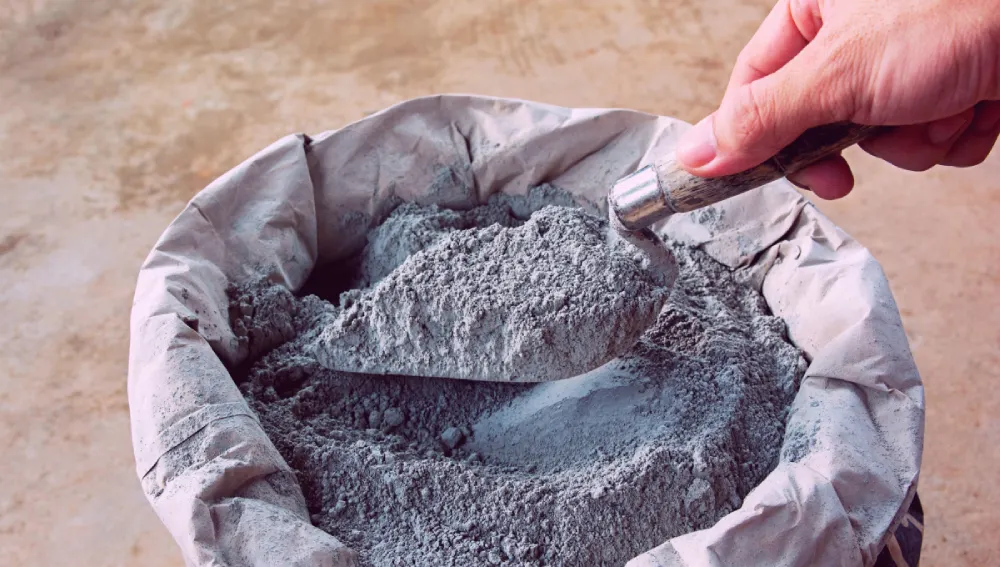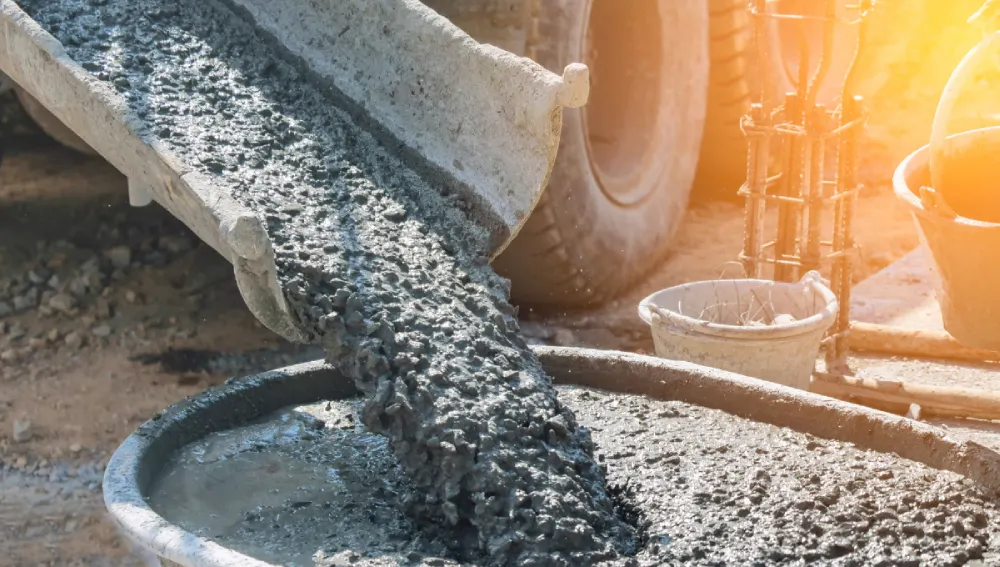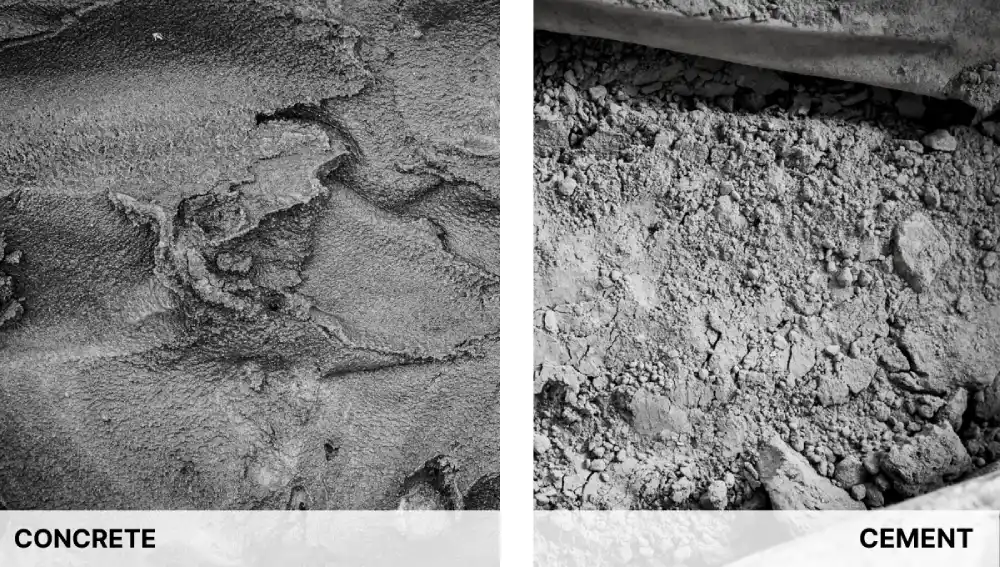Concrete and cement are crucial elements in construction. They bind together the building blocks of any building and give it shape, strength, and tenacity.
While undertaking your dream construction project, you might encounter commonly held doubts about what kind of cement mixture to use, when and where to use concrete, what types of concrete and cement are available, and much more. This article will lessen your burden in this doubtful scenario and help you learn the basic difference between concrete and cement, what they are, their kinds, and how they contribute to building construction.
The Basic Difference Between Concrete and Cement
Concrete and cement are distinct yet relative elements of construction. Concrete cannot exist without cement, and cement cannot be used much as an individual element unless mixed together with other components such as sand, gravel, crushed stones, and other aggregates.
| Features | Concrete | Cement |
| Function | Construction material. | Binding agent in concrete, mortar, etc. |
| Ingredients | Water, cement, sand, gravel. | Limestone, clay, gypsum. |
| Strength | High compressive strength and low tensile strength. | High compressive strength and .low tensile strength. |
| Used In | Used in building bridges, pavements, ceilings, etc. | Used to make concrete, mortar, plaster, and so on. |
| Appearance | Mostly grayish white. It can turn coloured with the addition of pigments. | Grayish white. |
| Workability | It has low to moderate to high workability. You can set its workability as per your project’s requirements. | It works best when mixed with water. |
| Setting Time | Varies based on the type of concrete. Typically, it takes some days to harden and set. | Sets and hardens quickly when mixed with water. |
| Durability | Highly durable. Can resist extreme weather conditions to a greater extent. | It can get cracked and damaged. |
| Water Resistance | Not usually waterproof. It can become water-resistant when mixed with elements that have water-resistance properties. | Not resistant to water. |
| Fire Resistance | Non-flammable, non-combustible, and non-explosive material. | Non-flammable, non-combustible, and non-explosive material. |
| Cost | Expensive than cement as it contains many ingredients like cement, sand, aggregates, water and admixtures. | Less expensive than concrete as it’s an individual material.. |
| Availability | Often mixed on site of construction. Its availability is highly dependent on the availability of cement and other materials. | Sold in bags in bulk quantities. |
How is Cement Made?

Cement is usually made from of limestone, clay, or gypsum.These components are crushed and added with iron ore, silica, or other materials to create the required cement type. The mixture is then burned in a kiln at extremely high temperatures and undergoes sintering, which turns the mixture into a clinker. The clinker is cooled down and ground into a fine powder called cement.
How is Concrete Made?

Concrete primarily consists of four components: Portland cement, water, sand and aggregates. The cement is mixed with water and other additives such as sand, crushed rocks, or gravel to make the concrete more compact. Water acts as a hydrating agent and helps create a paste-like substance along with the cement, which coats the aggregates.
Concrete Mixtures Proportions
The concrete mixture contains the ingredients in different proportions per construction requirements. The ingredients are mixed to form a uniform paste.
| Grade of the Concrete | Ratio (Cement:Sand:Coarse Aggregate) | MPa (Strength) |
| M5 | 1:5:10 | 5 |
| M7.5 | 1:4:8 | 7.5 |
| M10 | 1:3:6 | 10 |
| M15 | 1:2:4 | 15 |
| M20 | 1:1.5:3 | 20 |
Concrete grade refers to the minimum compressive strength of the mixture after 28 days since it was poured. The compressive strength of concrete is measured in megapascals and is denoted by MPa.
Types of Cement
Cement is usually differentiated based on its chemical composition and the resulting properties. Some widely available cement types include the following:
- Ordinary Portland Cement (OPC)
- Portland Pozzolana Cement (PPC)
- Portland Blast Furnace Slag Cement (PSC)
- White Cement
- Sulfate Resisting Cement (SRC)
- Rapid Hardening Cement (RHC)
- Quick-Setting Cement (QSC)
- Low Heat Cement (LHC)
- High Alumina Cement (HAC)
- Coloured Cement
- Air-Entraining Cement (AEC)
- Expansive Cement
- Hydrophobic Cement
- Pozzolanic Cement
Types of Concrete
Concrete types are categorized based on their strength, density, application, and other properties. Some of the types of concrete mixtures available are:
- Normal Strength Concrete (NSC)
- Reinforced Concrete (RC)
- Prestressed Concrete (PC)
- Plain or Ordinary Concrete
- Lightweight Concrete
- High-Density Concrete
- Stamped Concrete
- Air-Entrained Concrete (AEC)
- Ready-Mix Concrete
- Self-Consolidated Concrete (SCC)
- Decorative Concrete
- Polymer Concrete
- Rapid-Set Concrete
- Pervious Concrete
- Vacuum Concrete
- Shotcrete (Sprayed Concrete)
What is Best for Construction: Concrete vs Mortar?
Cement acts as a binding agent in both concrete and mortar mixtures. A concrete mixture consists of sand, water, and other aggregates alongside cement. A mortar mixture, on the other hand, consists of just cement, sand, and water alone.
Concrete and mortar mixtures come with unique perks and benefits. Concrete is recommended for structural applications that require high compressive strength, such as slabs, beams, pavements, and others. Mortar is helpful in filling gaps between bricks, stones, or blocks. It is also applied to stucco.
The pros and cons of concrete and mortar are as follows:
| Concrete | Mortar | |
| Pros | Highly durable, strong in compression, versatile, easily available, and cost-effective. | Highly adhesive, easily workable, and helpful in repair works. |
| Cons | Weak in tension, requires formwork for shaping. | It has lower strength than concrete |
Uses of Cement
Cement is a versatile component that is used in many areas of construction. Some of its common applications include:
- Concrete production
- Mortar manufacturing
- Plaster and stucco creations
- Creating grouts and others.
Uses of Concrete
Concrete finds applications in many ways. Its structural applications include:
- Foundations
- Slabs
- Beams and columns
- Walls
- Bridges
- Dams
- Tunnels
Non-structural applications include:
- Roads
- Sidewalks
- Driveways
- Parking lots
- Swimming pools
- Fountains
- Pipes
- Blocks
- Panels, and so on
Conclusion
Concrete and cement are highly helpful elements in construction. They help in different applications and provide benefits like strength, durability, structure, and more.
The choice of element to use for construction, whether concrete or cement or other aggregate, is based on the recommendation of the construction professionals. You can follow their guidance, refer to various sources, and find the right material for your construction projects.
FAQs
No, cement cannot be used in construction by itself. You can mix it with water and other materials to make concrete, mortar, or grout.
The quantity of cement required to make concrete depends on the grade of concrete you wish to make. Thus, based on the concrete’s desired strength, the necessary cement quantity will differ.
The initial setting time for concrete is 2 to 4 hours, and the final setting time is 6 to 12 hours. However, concrete continues to gain strength for nearly 28 days through curing.

